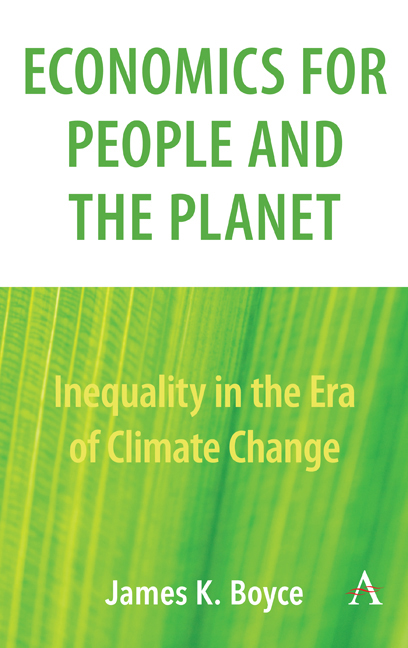Book contents
- Frontmatter
- Contents
- List of Illustrations
- Acknowledgements
- Part I Rethinking Economics and the Environment
- Part II Environmental Injustice
- Part III Climate Policy
- Chapter 17 Smart Climate Policy
- Chapter 18 Investment in Disadvantaged Communities
- Chapter 19 Dividends for All
- Chapter 20 Truth Spill
- Chapter 21 Four Pillars of Climate Justice
- Chapter 22 The Perverse Logic of Offsets
- Chapter 23 Climate Policy as Wealth Creation
- Chapter 24 The Carbon Dividend
- Chapter 25 Keeping the Government Whole
- Chapter 26 Air Quality Co-benefits in Climate Policy
- Chapter 27 Climate Adaptation: Protecting Money or People?
- Chapter 28 Forging a Sustainable Climate Policy
- Notes
- Publication History
- Index
Chapter 17 - Smart Climate Policy
from Part III - Climate Policy
Published online by Cambridge University Press: 12 February 2019
- Frontmatter
- Contents
- List of Illustrations
- Acknowledgements
- Part I Rethinking Economics and the Environment
- Part II Environmental Injustice
- Part III Climate Policy
- Chapter 17 Smart Climate Policy
- Chapter 18 Investment in Disadvantaged Communities
- Chapter 19 Dividends for All
- Chapter 20 Truth Spill
- Chapter 21 Four Pillars of Climate Justice
- Chapter 22 The Perverse Logic of Offsets
- Chapter 23 Climate Policy as Wealth Creation
- Chapter 24 The Carbon Dividend
- Chapter 25 Keeping the Government Whole
- Chapter 26 Air Quality Co-benefits in Climate Policy
- Chapter 27 Climate Adaptation: Protecting Money or People?
- Chapter 28 Forging a Sustainable Climate Policy
- Notes
- Publication History
- Index
Summary
Smart climate policy walks on three legs: public investment, carbon pricing and regulatory standards.
In a memorable moment in a memorable presidential campaign, candidate Barack Obama explained why he rejected John McCain's call to postpone their September debate in Oxford, Mississippi, during the negotiations on the first financial bailout package. ‘It's going to be part of the President's job,’ Obama declared, ‘to be able to deal with more than one thing at once.’
Something similar can be said about climate policy. A variety of proposals–for public investment, carbon pricing, regulatory standards–are cooking in Washington's political stew. Sometimes the proponents of specific policies are tempted to oversell their merits, while dismissing other policies as unnecessary or even counterproductive. But if political leaders and policy wonks are going to get smart on climate change, part of their job is to deal with more than one policy instrument at once.
Climate change cannot be reduced to single-issue politics. The challenge of weaning the United States from its dependence on fossil fuels that spew carbon into the Earth's atmosphere is inseparable from the challenges of reviving its economy, generating decent jobs and restoring its leadership in the international community.
Nor can climate change be treated effectively as a single-policy issue. Public investment is crucial, but it will not solve the problem alone. Ditto carbon pricing. Ditto regulatory standards. Each must be part of the solution, and each will enhance the effectiveness of the others. Choosing more than one item from the toolkit is the essence of smart climate policy.
Public Investment
In 2009, with the economy in its deepest crisis since the Great Depression–at a time when banks weren't lending, firms weren't investing, consumers weren't spending and jobs were disappearing–a big programme of public investment occupied the centre of the political stage.
Public spending, unlike tax cuts, directly boosts demand for goods and services. And unlike private consumption, a sizeable fraction of which goes into buying imports, public spending can be targeted to spur demand for goods and services produced at home.
As critics are quick to point out, public spending can be wasteful in the sense of creating nothing of lasting value. The government can inject a shortrun stimulus into the economy simply by paying people to dig holes in the ground and fill them up.
- Type
- Chapter
- Information
- Economics for People and the PlanetInequality in the Era of Climate Change, pp. 79 - 86Publisher: Anthem PressPrint publication year: 2019

